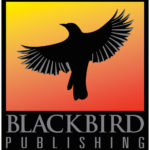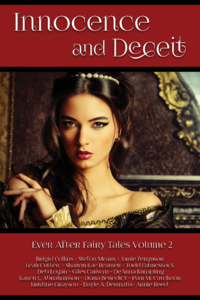“Beauty or Butterface?” is in Innocence and Deceit, the second volume in the Ever After Fairy Tales anthology series.
Enter the magical, unpredictable, wonderful world of fairy tales!
Meet Deb Logan!
Deb Logan writes light-hearted fantasy tales for middle grade readers and young adults. She also writes fantasy and paranormal romance as Debbie Mumford. She loves mythology, and is especially fond of Celtic and Native American lore.
“Beauty or Butterface?”
Philip doesn’t find a bride fast enough to suit his father in “Beauty or Butterface?” so the king writes Philip’s marriage into a treaty with the neighboring kingdom. Philip just has to choose between the other king’s twin daughters. What could be easier?
Excerpt
“Great news, Philip,” Dad said, wiping a bit of yolk from his chin. “I’m finalizing a treaty with Lindesland this morning. A very advantageous one. I’m sending you to Stefan’s kingdom. You’re to marry his daughter, and when the two of us are gone, our kingdoms will be merged. You and, eh, uhm, what’s her name will rule a new and vastly larger realm. Isn’t that exciting?”
The blood drained from my face. My appetite fled, and a knot of molten lead formed in my belly. “You’ve chosen my wife? Without even asking me?”
Confused disappointment dimmed Dad’s smile. He looked like I’d just refused the best gift in the world. Bewilderment glazed his eyes. He frowned momentarily before his gaze cleared and his smiled brightened.
“Not at all,” he cried, slapping his palm on the table. “I’ve forgotten the best part. Stefan has two daughters. Identical twins! You’ll have your choice of brides.”
I groaned and buried my face in my hands. Why did I have to be born a prince?
—from “Beauty or Butterface?” by Deb Logan
The Interview
Fairy tales were often cautionary tales, told to teach lessons. “Beauty or Butterface?” is a fun, lighthearted story, but it too contains a lesson. Why do you think fairy tales work so well for getting messages like this across?
I think it’s because fairy tales are stories about someone else’s experience. Reading (or listening to) another person’s story allows me to hear the lesson without having to acknowledge that it might apply to me. To think about the situation, be aware of the dangers, the possible pitfalls, and possibly even decide how I might react differently than the choice that was made in the story.
What difference do you see between today’s fairy tale retellings, and the types of fairy that were told hundreds of years ago?
When I was a kid, I loved fairy tales. But I grew up on significantly sanitized versions of the original tales. When I was about 12, my mother splurged and bought me a beautifully illustrated, hardbound version of the original Grimm’s Fairy Tales. I was so excited! Until I started reading.
Oh. My. God! The stories were horrifying! Not at all what I expected. The fairies weren’t gentle and kind creatures. They were cruel and spiteful and malicious. I closed the book and didn’t open it again for many years.
Depending on who’s writing, the fairy tales of today are either sanitized versions of the originals, or are horror stories brought into the present, or even the future. Frankly, the horror stories are truer to the originals, which weren’t intended to delight and entertain, but to forewarn and arm.
I definitely fall into the “delight and entertain” camp. But the other side makes for some fascinating reading!
What do you most enjoy about writing middle grade and young adult stories?
I love the wonder and the possibility of that age. The characters (and readers) have their whole lives in front of them, and while they face a lot of challenges, they also have a world of possibilities open to them. A lot of my stories focus on self-discovery, of finding out who you are, and just what it means to be you, with your particular strengths and weaknesses and funny little quirks.
We’re all unique, but until we accept ourselves it’s hard to move forward and attain our potential.
What fairy tale elements have you used in your Faery Chronicles series, and how do you feel they’ve enriched the stories?
As I said in the last question, it’s all about accepting who you are and learning to live with it!
The Faery Chronicles (Faery Unexpected, etc.) focus on Claire, a perfectly normal teenage girl who has a unique family heritage. She’s descended from a faery princess who deserted the throne of Faery and chose to marry a mortal. Claire is the culmination of her bloodline … the descendant who is destined to become a true faery and take her place in the royal succession.
Isn’t it every little girl’s dream to be a fairy princess? Claire discovers it’s not all pretty dresses and handsome princes.

Your novel Thunderbird incorporates elements of Native American mythology and history. What aspects of tribal legends helped inspire this story?
I grew up in Oklahoma with the tales of the Five Civilized Tribes, the Cherokee, Chickasaw, Choctaw, Creek, and Seminole. Later, I lived in Montana and became familiar with the Crow, Blackfoot, and Shoshone. Later still, when we made our home in Colorado where I read a lot about the Ute and the Lakota. Consequently when I write Native American themed tales, they borrow from many sources.

Thunderbird draws on the shamanic tradition, including traditional gods and spirit guides. It also draws from the great archaeological work done in Montana as represented by the Museum of the Rockies … a place we visited frequently when we lived in Bozeman.
You write middle grade/young adult fiction as Deb Logan, and write stories for a slightly older crowd as Debbie Mumford. How do you balance the two different aspects, and is there ever any overlap?
I chose to write for the young (and the young at heart!) as Deb Logan because that’s my maiden name. Essentially, Deb channels my younger self! Interestingly enough, except for rare exceptions, Deb writes in first person and Debbie writes in third. Weird, huh?
I think that’s partly because Deb’s stories are often based (very loosely) on my own life, while Debbie’s are pure speculation. For instance, Dani Erickson is the youngest of seven siblings, and the only girl. I am the youngest of six siblings, and the only girl. That’s about where the similarities end though. Dani is an hereditary demon hunter. I am (and always was) a studious reader! But … Dani and I both know how to deal with boys! And we both have very savvy mothers.
So far, there hasn’t been any overlap between my alter egos, although the characters in my “Seer Chronicles” series are growing up, and getting closer to Debbie’s audience. Those stories, which began as young adult, are now really “new adult” … we’ll just have to wait and see what happens!

What story (or stories) are you working on now, and what’s fun about what you’re writing?
I’m currently writing another Dani Erickson story and am hoping to get to the sequel to Thunderbird! Coyote will focus on Justin Prentiss and … well, Coyote!
I have one young fan who contacts me on a regular basis to ask about this novel, so I really need to get moving! I may have to dedicate it to Emily since she’s being such an inspiration. *lol*
About Deb
Deb Logan writes children’s, tween, and young adult fantasy. Her stories are light-hearted tales for the younger set—or ageless folk who remain young at heart. She’s published 14 titles, including short stories, collections, and novels and has been featured in several anthologies. Author of the popular “Dani Erickson” series, Deb loves dragons and faeries and all things unexplained.
Find Deb
Website ~ Facebook ~ BookBub ~ Amazon ~ Goodreads
Find Innocence and Deceit!
Amazon ~ Barnes & Noble ~ Kobo ~ Apple Books ~ Books2Read ~ Goodreads


Sign up for the Blackbird Publishing newsletter!

